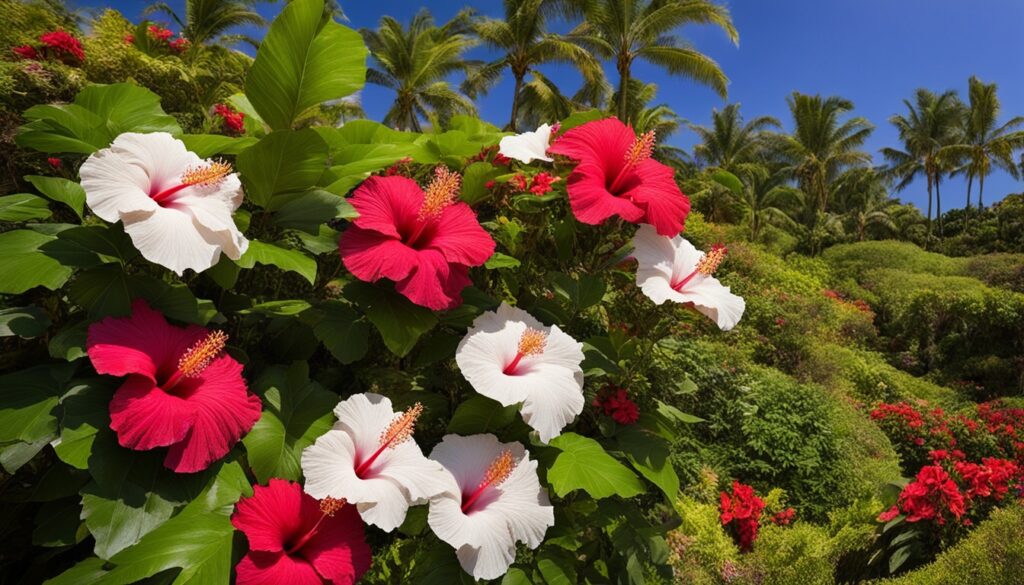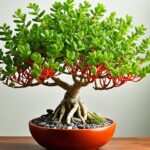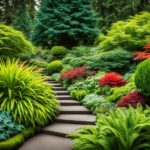When I stepped into my Hawaiian garden, the colors and greenery amazed me. The warm breeze brought the sweet smell of plumeria, connecting me to this tropical paradise. My love for Hawaiian plants started as a hobby but grew into a big passion.
In this guide, I’ll share my experiences with plants in Hawaii. We’ll look at native and exotic plants. We’ll also learn about tropical landscaping and how to make your own paradise. This journey is for everyone, whether you’re an expert or just starting.
Key Takeaways
- Hawaii has a unique ecosystem with many rare and diverse plants.
- Both native and introduced plants do well in Hawaiian gardens.
- Tropical plants include beautiful flowers, fruit trees, and native species.
- Gardening in Hawaii means adapting to its special climate.
- It’s important to garden sustainably to protect Hawaii’s ecosystems.
Introduction to Hawaiian Garden Plants
Hawaii’s landscapes are a dream for garden lovers. The islands are full of native and introduced plants. Exploring this tropical paradise, I’m struck by the unique plants that grow here.
Native vs. Introduced Species
Hawaii’s plants are a mix of native and new ones. About 1,100 species are found only here. These native plants grew naturally over millions of years.
Introduced plants came with people. Now, there are 6,000 to 12,000 non-native plants in Hawaii.
Importance of Native Plants in Hawaiian Ecosystems
Native plants are vital to Hawaii’s ecosystems. They feed and shelter native animals and keep the islands diverse. But, many are in danger. Sadly, some are already extinct.
Conservation efforts are crucial to save these plants.
Adapting to Hawaii’s Unique Climate
Adapting to Hawaii’s climate is important. The islands have different landscapes, each with its own climate. When picking plants for my garden, I think about sunlight, rain, and soil.
Choosing native plants is often best. They’re already adapted to the local conditions.
| Plant Type | Number of Species | Status |
|---|---|---|
| Endemic | 1,100 | Unique to Hawaii |
| Indigenous | 109 | Native but found elsewhere |
| Polynesian-introduced | 27 | Brought by early settlers |
| Naturalized | 1,539 | Non-native, growing wild |
Native Hawaiian Plants for Landscaping
I’ve found that using native plants in Hawaii brings beauty and toughness to gardens. These plants do well in tough conditions, making them great for eco-friendly gardens. Let’s look at some Hawaiian groundcovers that can change your outdoor area.
‘Ākia (Wikstroemia uva-ursi)
‘Ākia is a popular choice for landscaping because it’s tough. It grows 1-3 feet tall and spreads up to 10 feet wide. Its shiny leaves and red berries make any garden look interesting.
‘Ilima Papa (Sida fallax)
‘Ilima Papa is a small Hawaiian groundcover, growing 6 inches to 1 foot tall. It has bright yellow flowers that look like tiny hibiscus and are used in making leis. It takes about 1000 ‘Ilima Papa flowers to make one lei.
Pōhinahina (Vitex rotundifolia)
Pōhinahina, or beach vitex, grows fast and can get up to 2 feet tall. Its leaves are silvery with a hint of lavender and its purple flowers smell great, making it a standout in native gardens.
Pā’ū o Hi’iaka (Jacquemontia ovalifolia)
Pā’ū o Hi’iaka is a small plant with pale blue or white flowers. It’s perfect for those who want plants that can handle drought in their Hawaiian gardens.
| Plant Name | Height | Spread | Flower Color | Special Features |
|---|---|---|---|---|
| ‘Ākia | 1-3 feet | Up to 10 feet | N/A | Red berries, waxy leaves |
| ‘Ilima Papa | 6 inches – 1 foot | Varies | Yellow | Used for lei-making |
| Pōhinahina | 6 inches – 2 feet | Varies | Lavender | Silvery leaves, fragrant flowers |
| Pā’ū o Hi’iaka | Low-growing | Varies | Pale blue or white | Drought-tolerant |
These plants are not just pretty; they’re also made for Hawaii’s climate. By adding these native species to your garden, you’re helping local ecosystems and making a sustainable landscape. It’s a way to show the true spirit of the islands.
Ornamental Trees and Shrubs
I love adding Hawaiian trees and tropical shrubs to gardens. They make any garden look unique and beautiful. Plants like Acacia koa, Cordia subcordata (kou), and Metrosideros polymorpha (‘ōhi’a lehua) have amazing leaves and flowers.
Pritchardia palms are native to Hawaii and add a tropical feel. For dry spots, Dodonaea viscosa (‘a’ali’i) and Myoporum sandwicense (naio) are great choices. They’re perfect for gardens that need to be sustainable.
When picking trees and shrubs, think about how big they’ll get and how they’ll spread. Here’s a look at some popular ones:
| Plant | Height (feet) | Width (feet) | Zones |
|---|---|---|---|
| Malus selections (Crabapple) | 6-30 | 6-30 | 4-8 |
| Cercis canadensis (Redbud) | Up to 10 | Varies | 5-9 |
| Lagerstroemia (Crape Myrtle) | 6-25 | 6-25 | 6-9 |
| Cornus florida (Flowering Dogwood) | 15-30 | 15-30 | 5-9 |
| Magnolia x soulangeana (Saucer Magnolia) | Up to 25 | Up to 25 | 4-9 |
These trees and shrubs do more than just make your garden look good. They help local ecosystems too. By picking native Hawaiian plants, you support local wildlife and keep the islands beautiful.
Colorful Flowers for Hawaiian Gardens
I love exploring the vibrant world of tropical flowers in Hawaiian gardens. The islands are full of exotic blooms that make stunning, colorful gardens. Let’s check out some of the most eye-catching flowers you can find in paradise.
Hibiscus Varieties
Hibiscus, Hawaii’s state flower, is a must-have in any island garden. These tropical flowers bloom every day, adding fresh colors. I’m always amazed by the many hibiscus types, from the native white Hibiscus arnottianus to the red and yellow ones.

Blue Jade Vine
The Blue Jade Vine (Strongylodon macrobotrys) is a real showstopper. Its cascading turquoise flowers look almost magical. This exotic bloom adds a unique touch to Hawaiian gardens, making them feel like a tropical paradise.
Hanging Lobster Claw
Heliconia rostrata, or Hanging Lobster Claw, is another favorite of mine. Its vibrant pink and green flower clusters hang like colorful ornaments. These plants are great for adding drama to your garden.
| Flower | Bloom Color | Native to Hawaii |
|---|---|---|
| Hibiscus | Various | Yes (some species) |
| Blue Jade Vine | Turquoise | No |
| Hanging Lobster Claw | Pink and Green | No |
These tropical flowers not only make beautiful gardens but also support local ecosystems. Did you know that 89% of plant species in Hawaii are unique to the islands? By adding these blooms, you’re helping to preserve Hawaii’s rich botanical heritage.
Garden Plants for Tropical Landscaping
I love making gardens that feel like a tropical paradise. Choosing the right plants is crucial for tropical landscaping. Let’s check out some great options for your garden.
Ferns are essential for that tropical vibe. I often pick Nephrolepis cordifolia, or kupukupu, as a lush groundcover. It’s great for filling gaps and adding texture.
Pandanus tectorius is my top pick for unique shapes. Its striking look and interesting leaves stand out in any tropical garden.
Beach naupaka (Scaevola taccada) is another favorite. It’s tough and can handle salt, making it perfect for coastal areas or tough soil.
When planning your tropical paradise, keep these plant facts in mind:
- 17 varieties of ColorBlaze foliage plants
- 20 varieties of Heart to Heart Caladiums
- 4 colors in the Hippo series of Polka Dot Plants
- 10 varieties of sweet potato vines
Successful tropical landscaping is about layering. I suggest mixing tall shrubs (5′ to 10’+), medium shrubs (3′ to 5′), and groundcovers. This adds depth and interest.
| Plant Type | Recommended Varieties | Best Planting Season |
|---|---|---|
| Trees and Shrubs | Over 30 species | Spring through Fall |
| Vines | Over 10 species | Late Spring through Fall |
| Groundcovers | Ferns, Caladiums, Sweet Potato Vines | Spring through Fall |
With the right plant choices and garden design, you can make a stunning tropical landscape. It will thrive in your local climate.
Edible Plants in Hawaiian Gardens
I love the idea of edible landscaping in Hawaii. The tropical climate here is perfect for growing delicious fruits, herbs, and vegetables. Let’s explore some great options for creating an edible paradise in your Hawaiian garden.
Fruit Trees
Tropical fruits thrive in Hawaii’s warm weather. Papaya trees grow quickly and produce fruit year-round. Mango trees offer sweet, juicy fruit in summer. Citrus trees like lemon and lime do well too. For something unique, try planting a mountain apple (‘Ohi’a ‘ai) tree. These crunchy fruits are packed with vitamins and minerals.

Hawaiian Herbs and Spices
Growing Hawaiian herbs adds flavor to your meals and beauty to your garden. Lemongrass is easy to grow and makes great tea. Thai basil thrives in our climate and adds zest to many dishes. Don’t forget about ‘olena (turmeric), a native plant with both culinary and medicinal uses.
Vegetables for Hawaiian Gardens
Many vegetables grow well in Hawaii’s climate. Taro and sweet potatoes are staples of Hawaiian cuisine. Leafy greens like lettuce and kale grow fast from fall to spring. For summer, try tomatoes, peppers, and corn. Remember to protect your veggies from pests with covers or natural sprays.
| Season | Recommended Vegetables |
|---|---|
| Winter | Arugula, Lettuce, Kale, Leeks, Cauliflower, Beets, Carrots |
| Spring | Pole Beans, Cabbages, Kale, Peppers, Onions, Sweet Potatoes, Cucumber |
| Summer | Tomatoes, Peppers, Eggplant, Corn, Okra, Melons |
| Fall | Pumpkin, Spinach, Bok Choy, Daikon, Radish, Celery |
When planning your edible garden, consider your yard’s microclimates and irrigation needs. With a little care, you can enjoy fresh, homegrown produce all year round in beautiful Hawaii.
Care and Maintenance of Hawaiian Garden Plants
I love tending to my Hawaiian garden. It’s important to know how to care for and maintain it. Here are some tips I’ve learned over the years.
It’s important to understand what each plant needs. Most Hawaiian plants can handle drought once they’re established. But, they need regular watering when they’re young. I water my plants deeply and often to help their roots grow deep.
This way, they can better handle drought. It’s also better for them than watering too little or too much.
The type of soil you have matters a lot. My garden has loamy soil, which keeps moisture but also drains well. If you have clay or sandy soil, you might need to adjust how often you water.
- Mulching helps retain moisture and suppress weeds
- Regular pruning maintains plant shape and health
- Watch for pests like whiteflies, mealybugs, and scale insects
I’m careful with fertilizing my plants. Native plants don’t need a lot of fertilizer. Too much can be harmful. Instead, I use compost a little bit. For pests, I use safe methods to protect my garden.
Remember, gardening in the tropics takes time. Some plants take months to get going, while others might take years. But with the right care, your Hawaiian garden will become a beautiful, lasting part of your landscape.
Conservation and Sustainability in Hawaiian Gardening
Hawaiian gardening is a chance to use sustainable practices and protect plants. The islands have a rich variety of life and delicate ecosystems. Gardeners like us must take special care.
Preserving Endangered Species
Hawaii’s plants are very unique, with most flowering plants found only here. Sadly, 72% of these plants are at risk of disappearing. By adding these rare plants to my garden, I can help save them.
Water Conservation Techniques
Water is very valuable in Hawaii. I’ve found ways to save it. Using rainwater for my garden is a big help. I also use efficient irrigation systems to avoid wasting water.
Eco-friendly Pest Control
Using harmful chemicals is not sustainable. I welcome butterflies and native crickets to my garden. These insects help control pests naturally, so I don’t need pesticides.
| Sustainable Practice | Benefit |
|---|---|
| Composting | Speeds up organic matter decomposition, provides nutrients |
| Attracting beneficial insects | Natural pollination, reduces need for pesticides |
| Proper nutrient management | Prevents soil pollution, protects water sources |
| Slow-release fertilizers | Enhances soil health, prevents nitrogen runoff |
By using eco-friendly methods, I’m doing more than making a pretty garden. I’m helping protect Hawaii’s unique plants and ecosystems. It’s a fulfilling way to love gardening and care for the environment.
Conclusion
I’ve looked into the beauty of Hawaiian plants and how to plan a garden in this guide. Making a tropical paradise in your yard is a fun adventure. You’ll find everything from native ‘Ākia plants to bright hibiscus flowers in Hawaii’s gardens.
Planning a garden in Hawaii needs careful thought. You can mix native and new plants for beautiful scenes that help local ecosystems. Always think about Hawaii’s climate when picking plants. Using less water and fighting pests in an eco-friendly way is important for a green garden.
My exploration of Hawaiian gardens has shown me the happiness of being close to nature. Gardening is good for your health, offering exercise and stress relief. It’s a way to connect with your family and make a special place. Whether you’re experienced or new to gardening, Hawaii’s plants offer endless ideas for your tropical garden.
FAQ
What is the difference between native and introduced plants in Hawaii?
What are some popular native Hawaiian plants for landscaping?
What are some colorful flowers that can be grown in Hawaiian gardens?
Can I grow edible plants in my Hawaiian garden?
What are some tips for caring for Hawaiian garden plants?
How can I incorporate sustainable practices in my Hawaiian garden?
Source Links
- University of Hawaii – Master Gardener Program
- Tropical Topics: Links for Hawaiʻi Gardeners
- Plants Of Hawaii – Bishop Museum
- Native Hawaiian Garden (7722) – Pā‘ū-o-Hi‘iaka
- Let’s Go! Native Plants, Hawai’ian Style
- Native Hawaiian plants for landscaping, conservation, and reforestation
- The Weatherproof Warriors: 5 Native Plants For Your Authentic Hawaiian Landscape — Kauai Seascapes Nursery
- Notable Natives: Large Shrubs and Small Trees – Ecological Landscape Alliance
- Top Ten Tried & True Ornamental Trees & Shrubs for North Texas
- 19 Small Trees for Front Yards That Will Add Tons of Color to Your Landscape
- Hawaiian Flowers: 21 Different Flowers Found Only in Hawaii
- Tropical Hawaiian Flowers To Plant In Your Garden – Spotlight Hawaii
- 13 Tropical Garden Plants for Your Outdoor Oasis
- Trees & Shrubs for a Tropical Look
- Starting a Community Garden: A Step-by-Step Guide
- Edible Plants – Heidi Bornhorst
- Vegetables in Hawaii – This Hawaii Life
- A Native Hawaiian Garden: How to Grow and Care for Island Plants
- Sharing our ‘Why’: Gardening with Hawaiian Plants
- Native Hawaiian Plants – Board of Water Supply
- 8×11.p65
- Aloha ʻĀina: Conserving Hawai’i’s Native Flora – Center for Plant Conservation
- Essay on Garden for Students and Children | 500+ Words Essay
- Gardening for health: a regular dose of gardening


